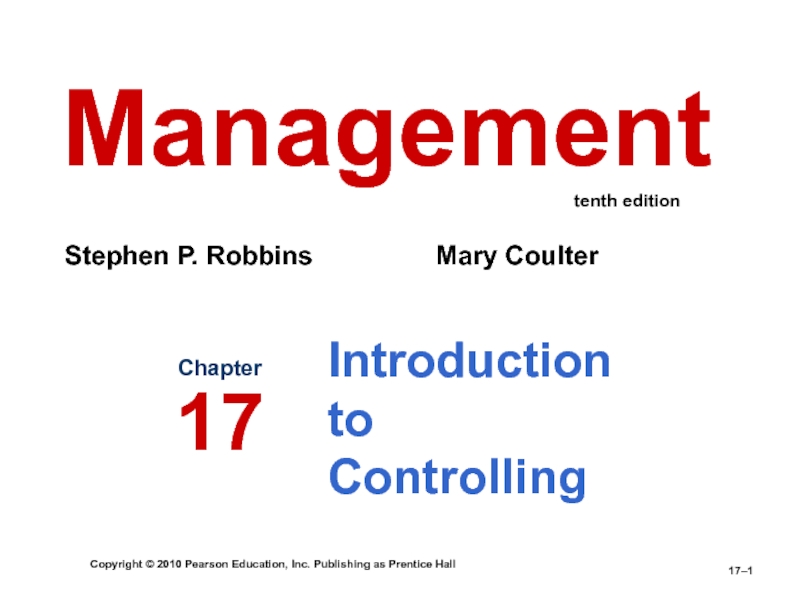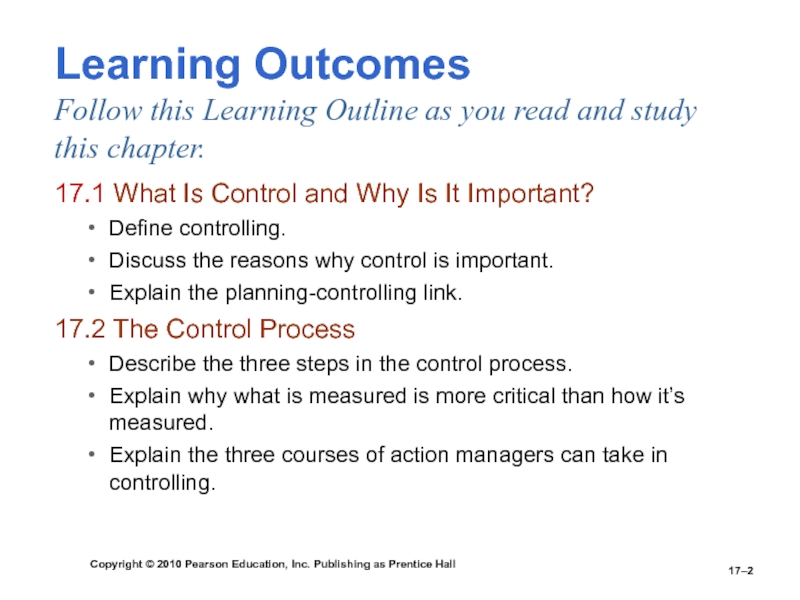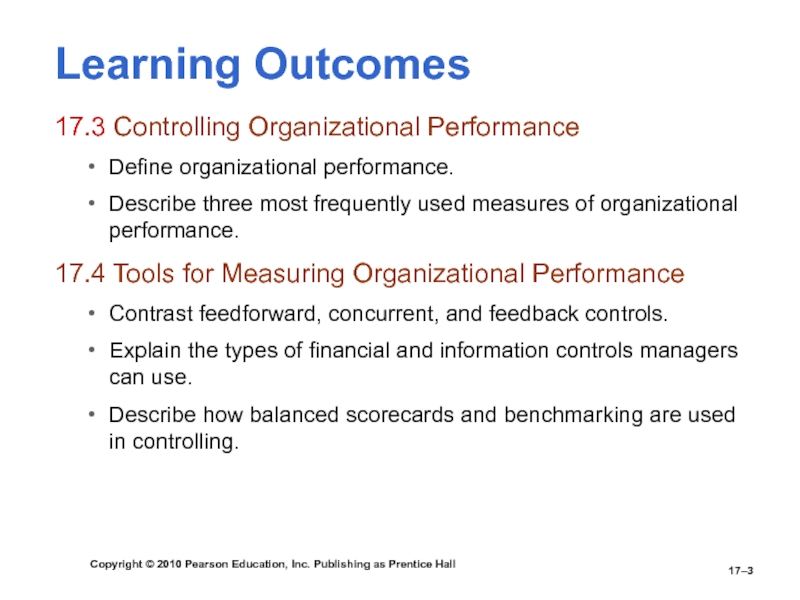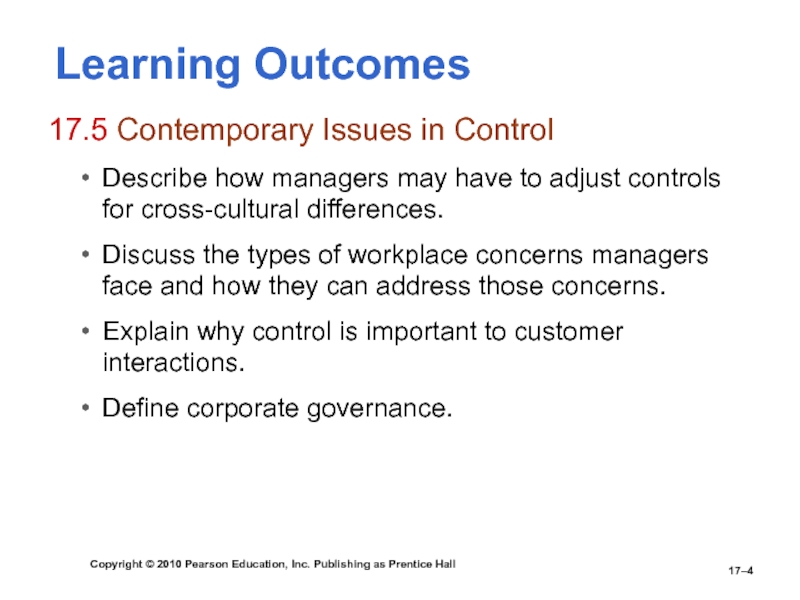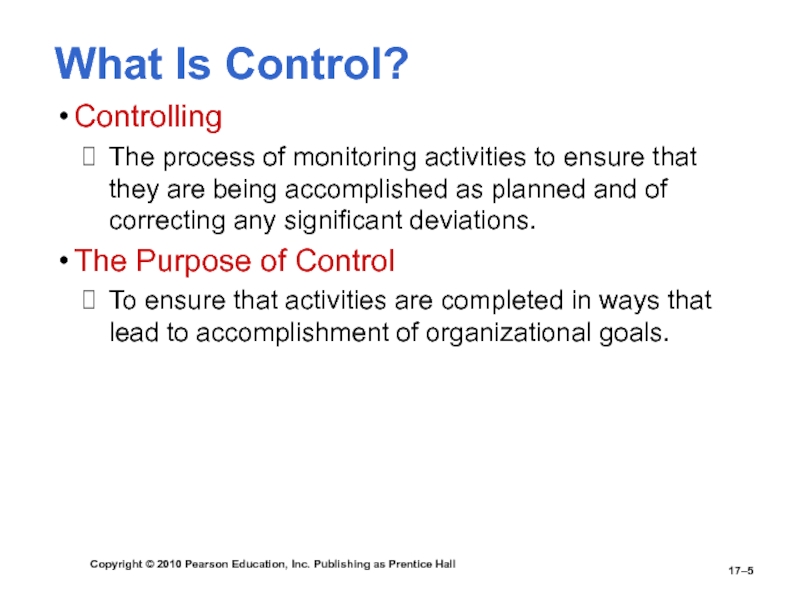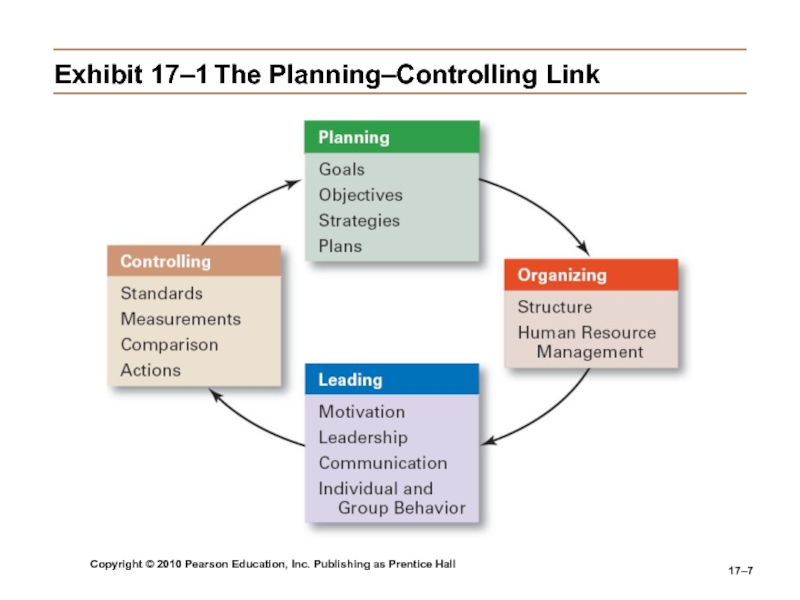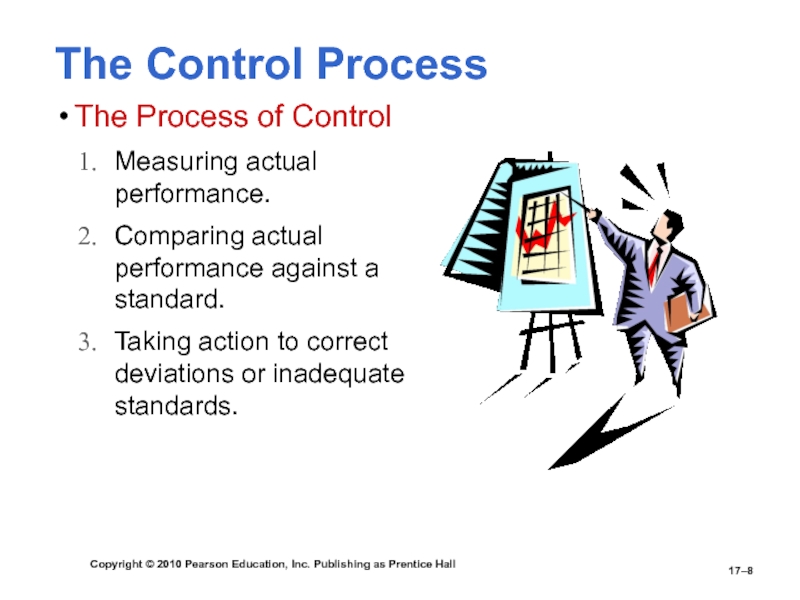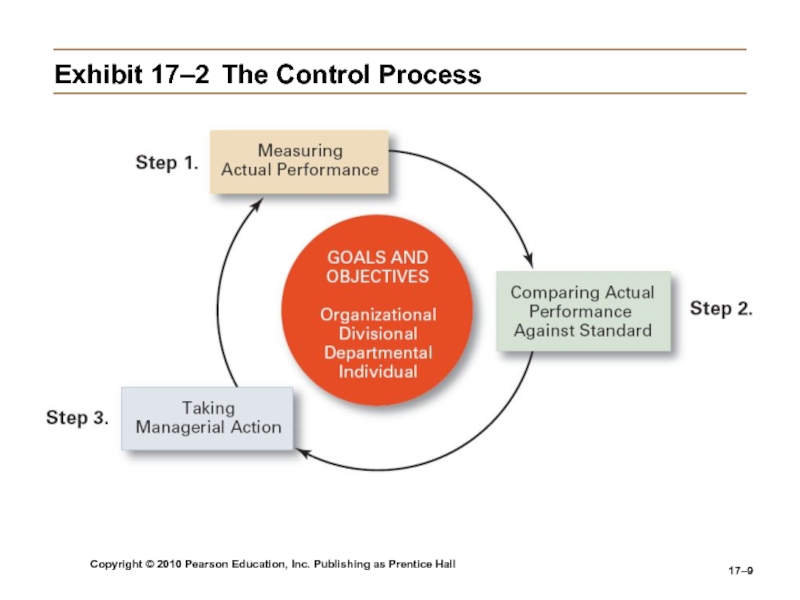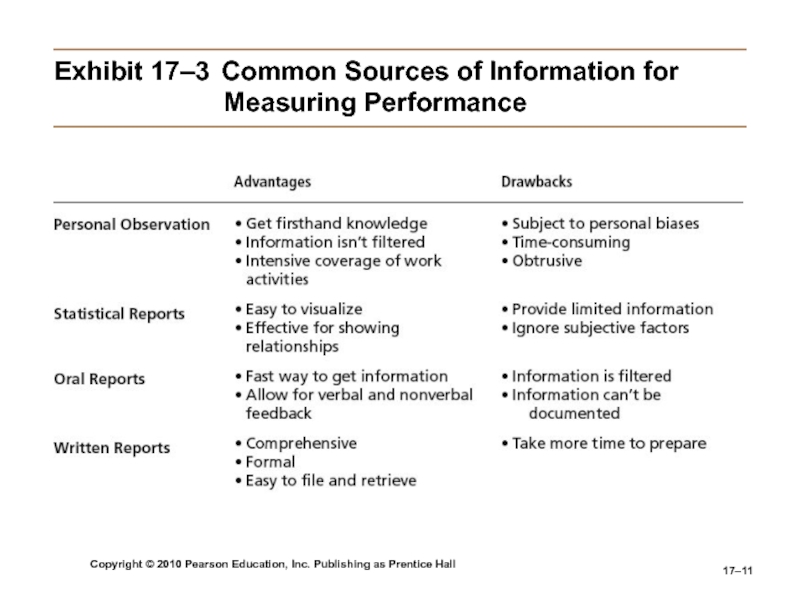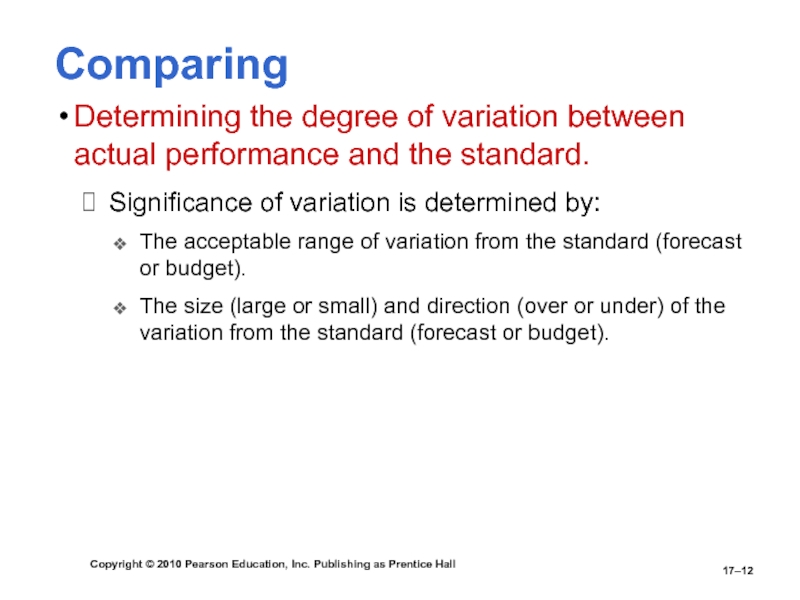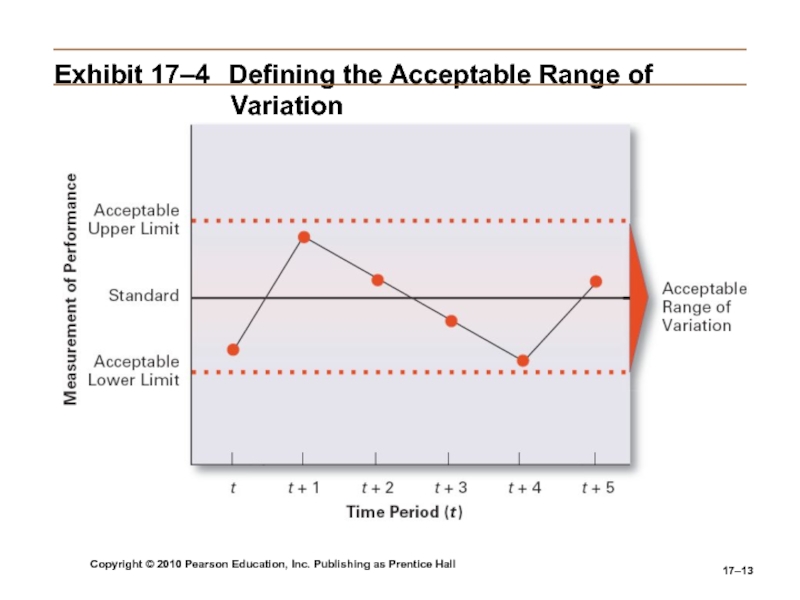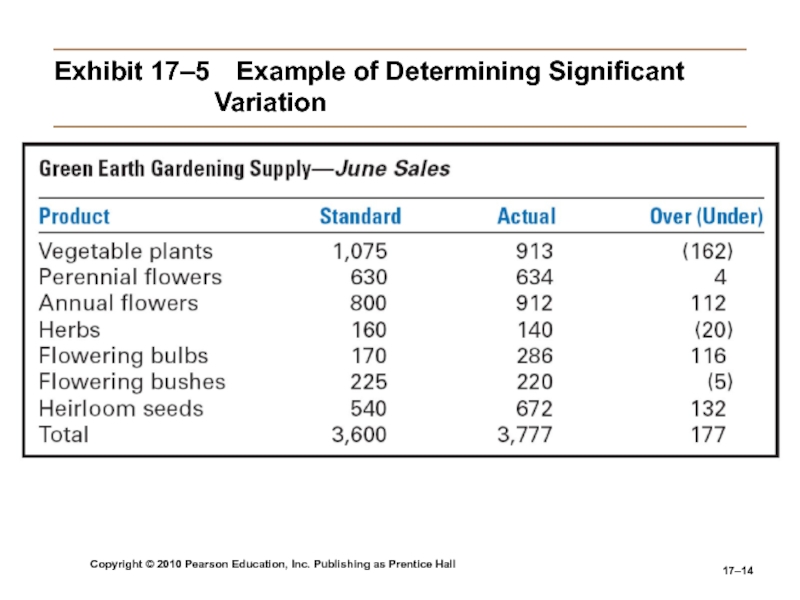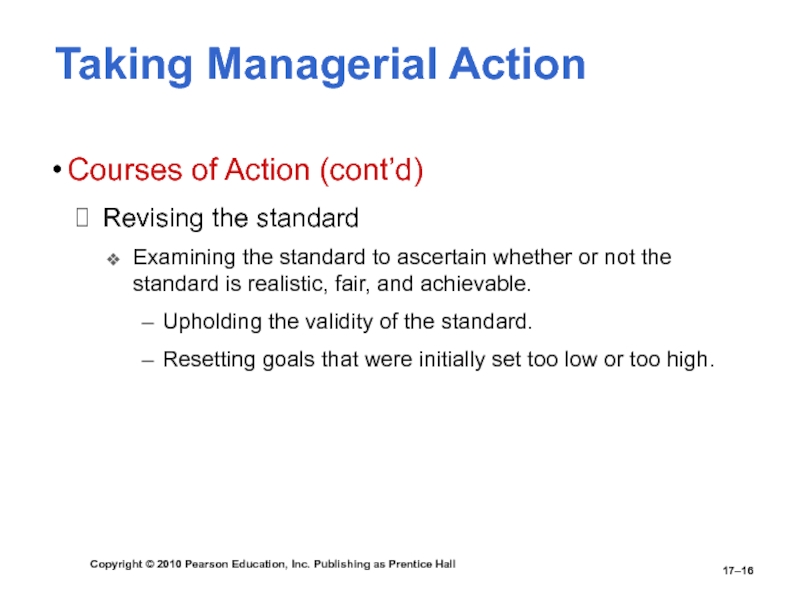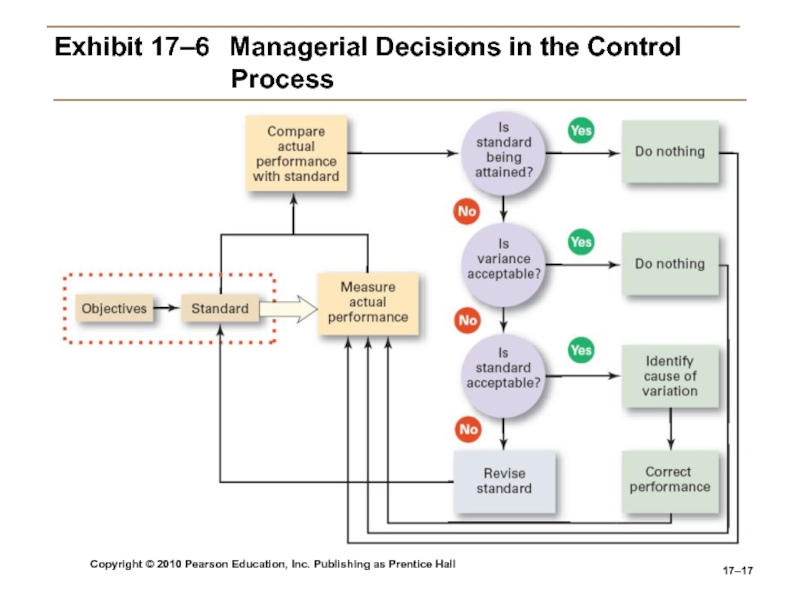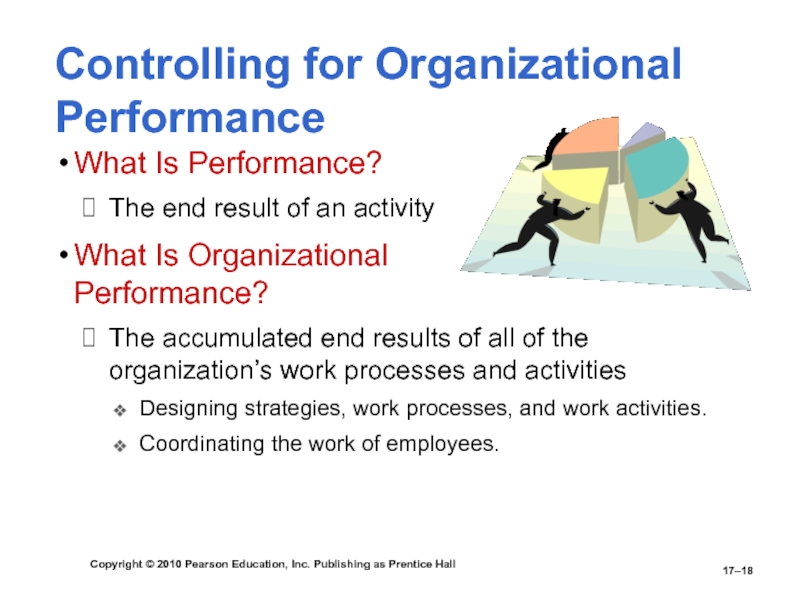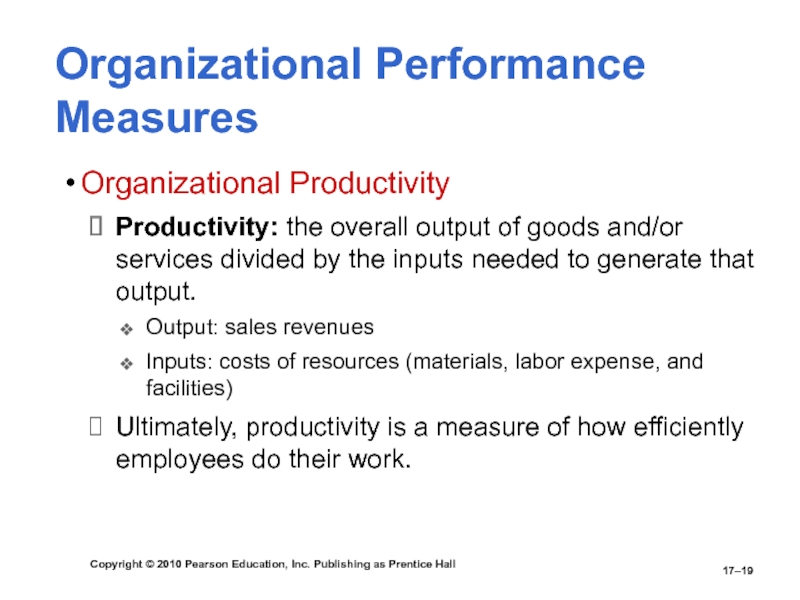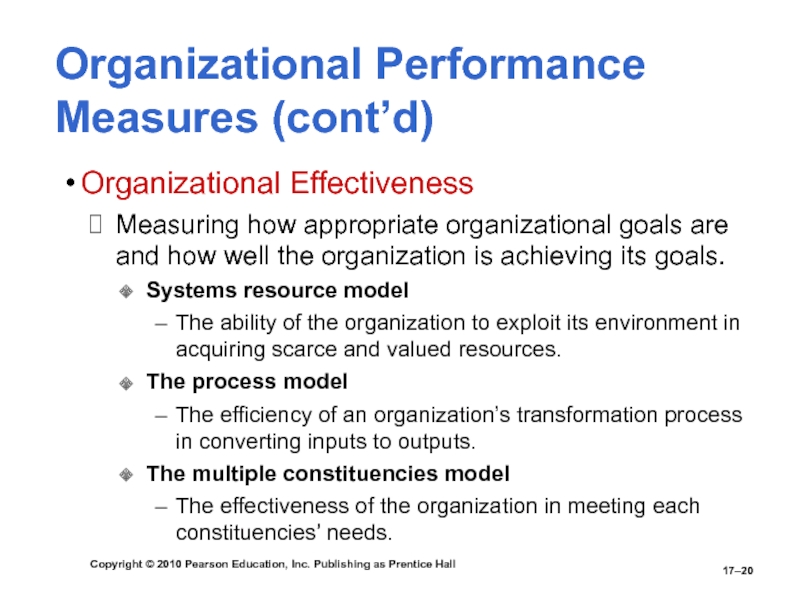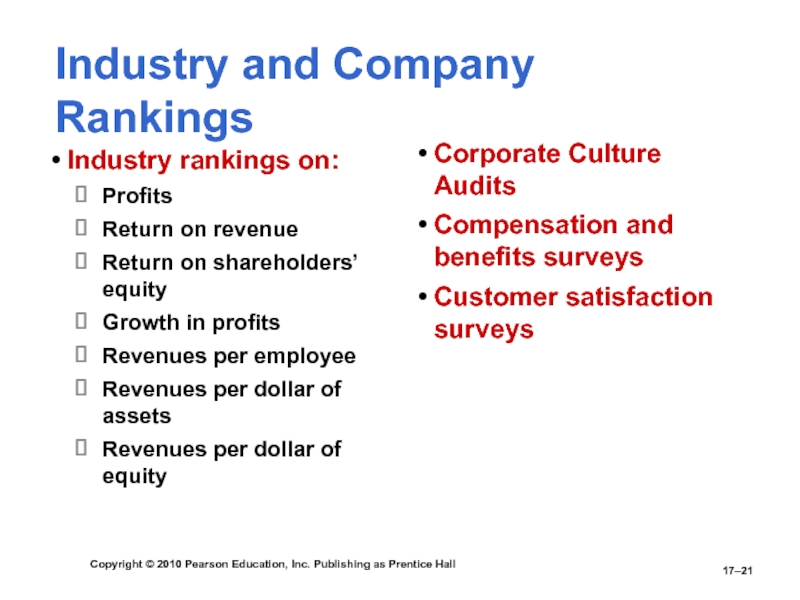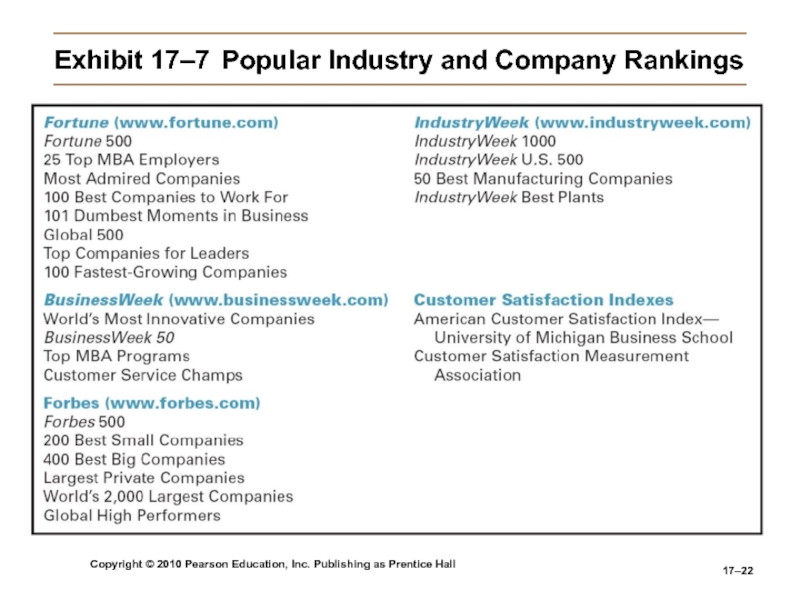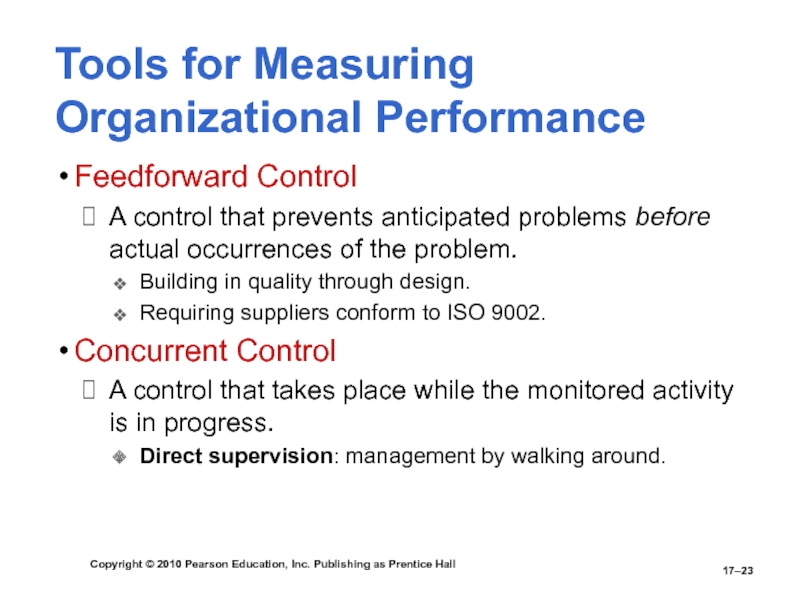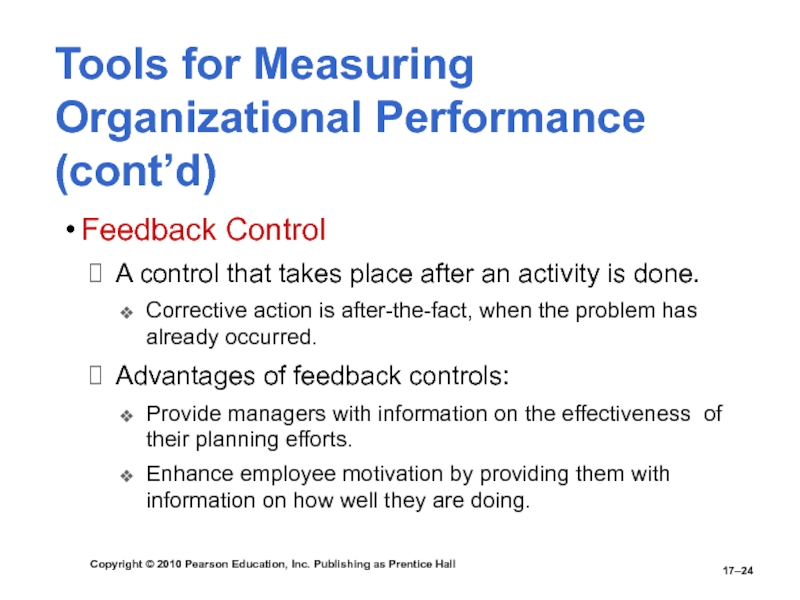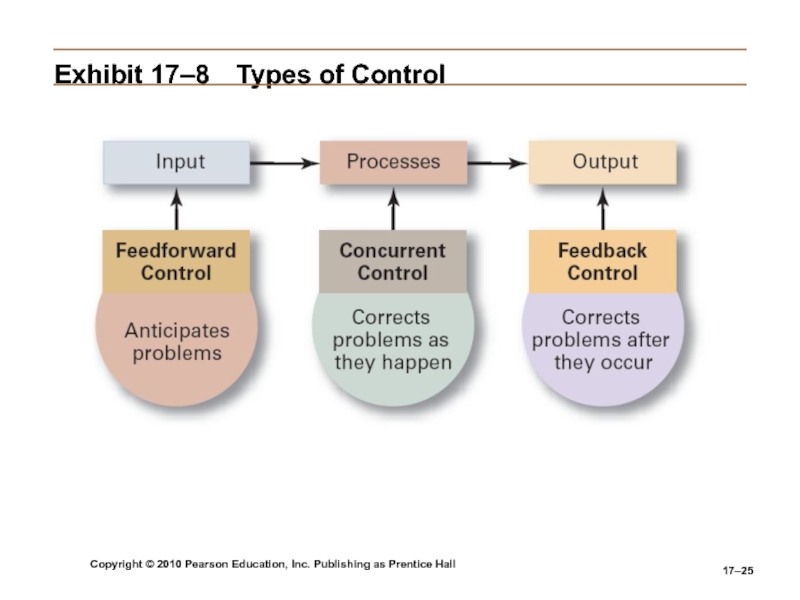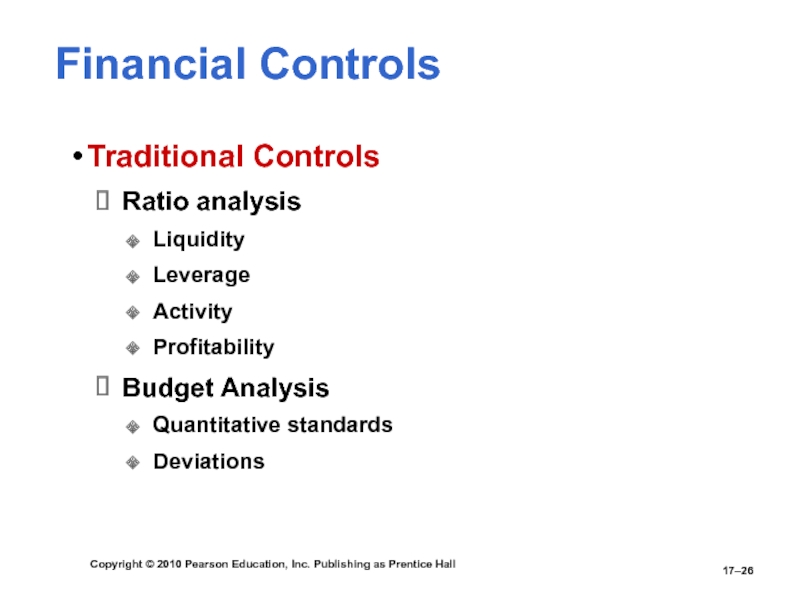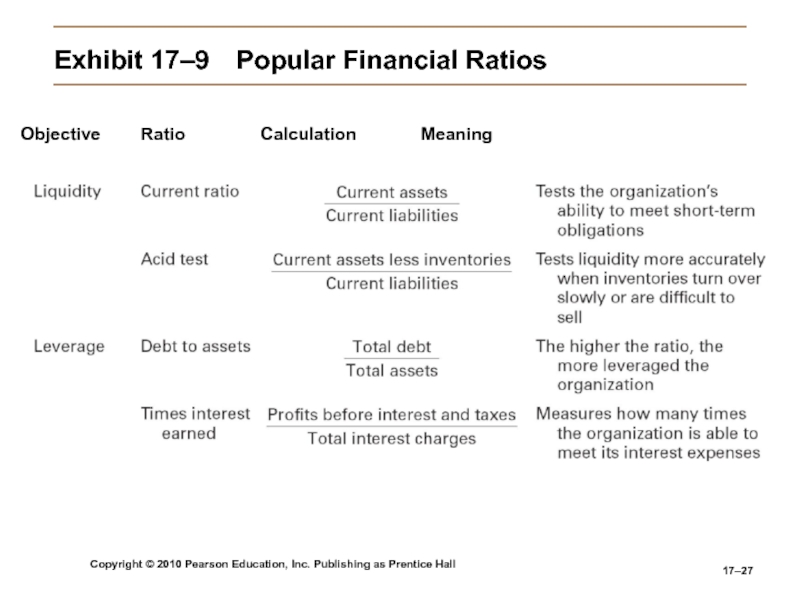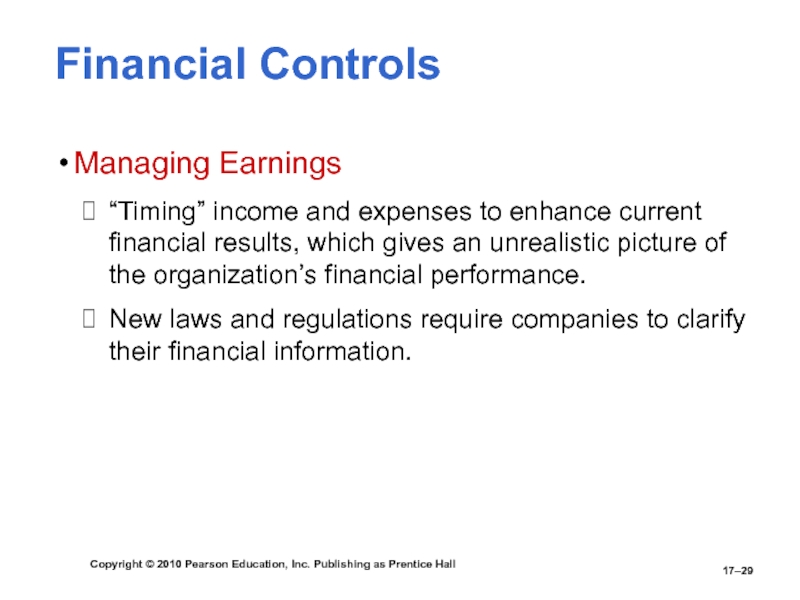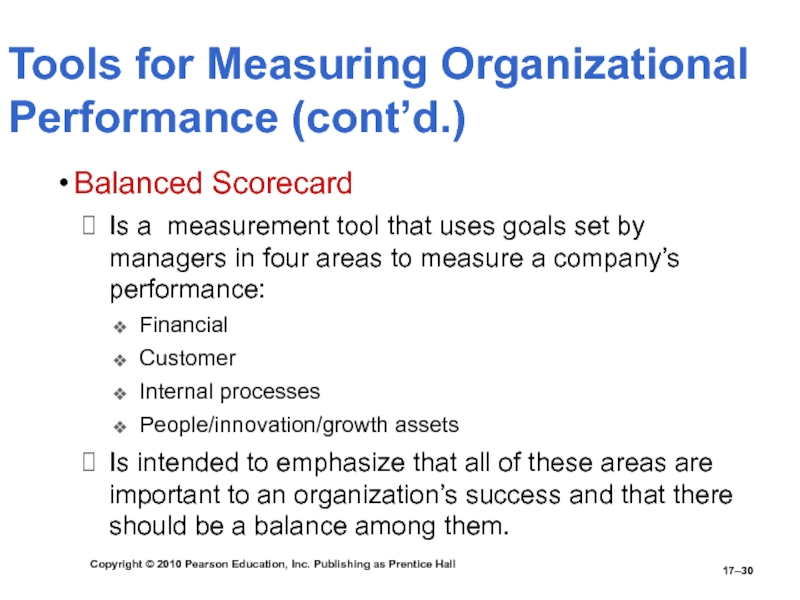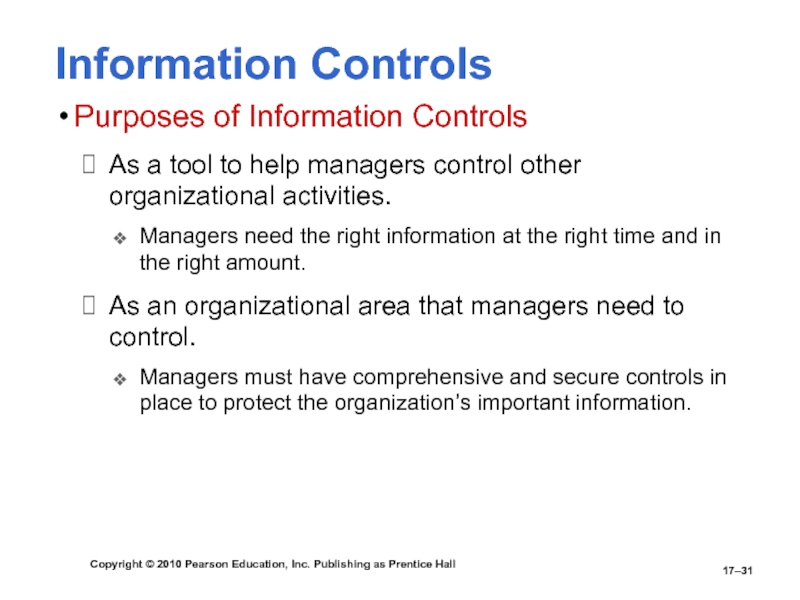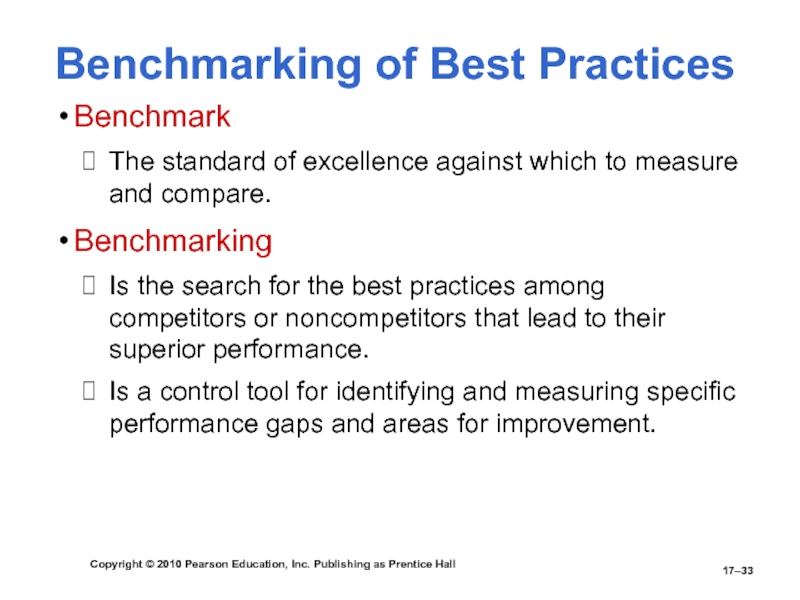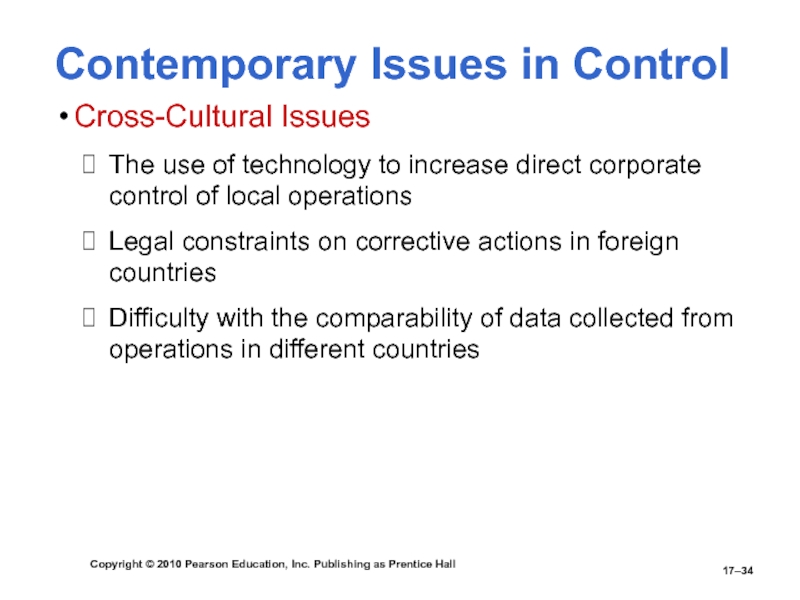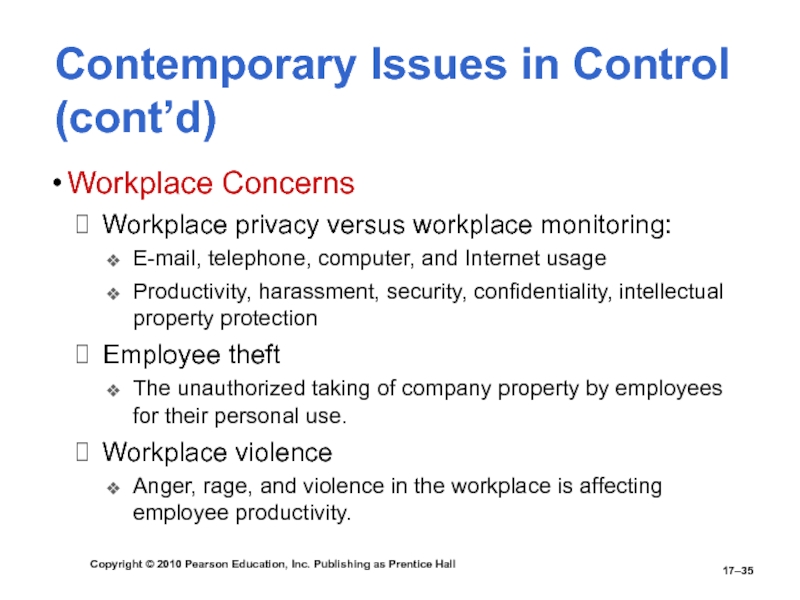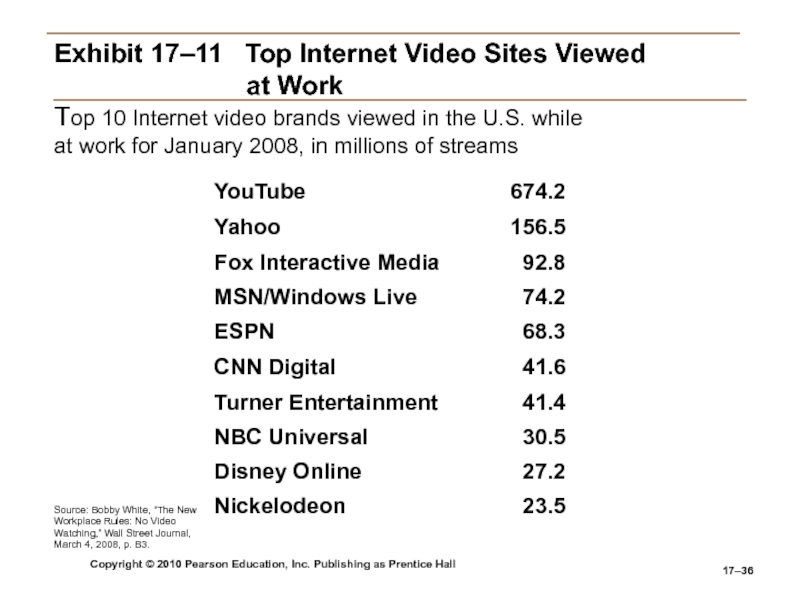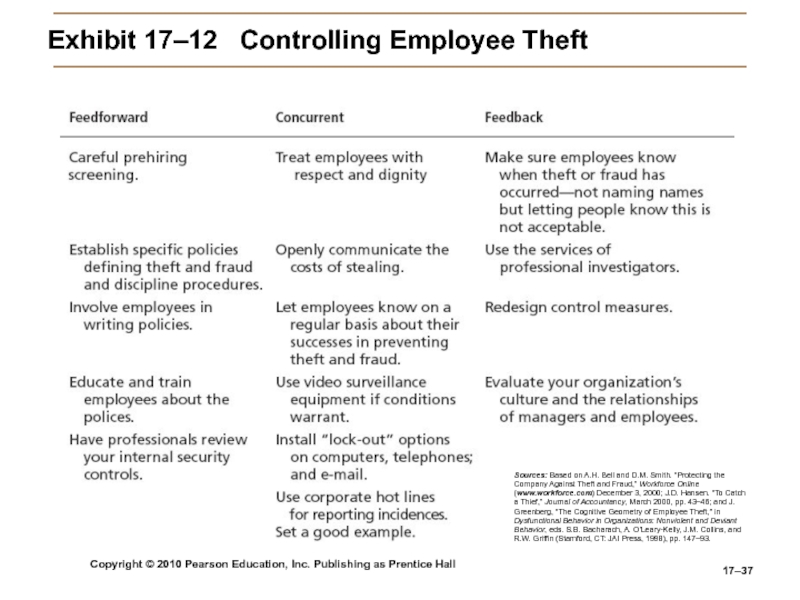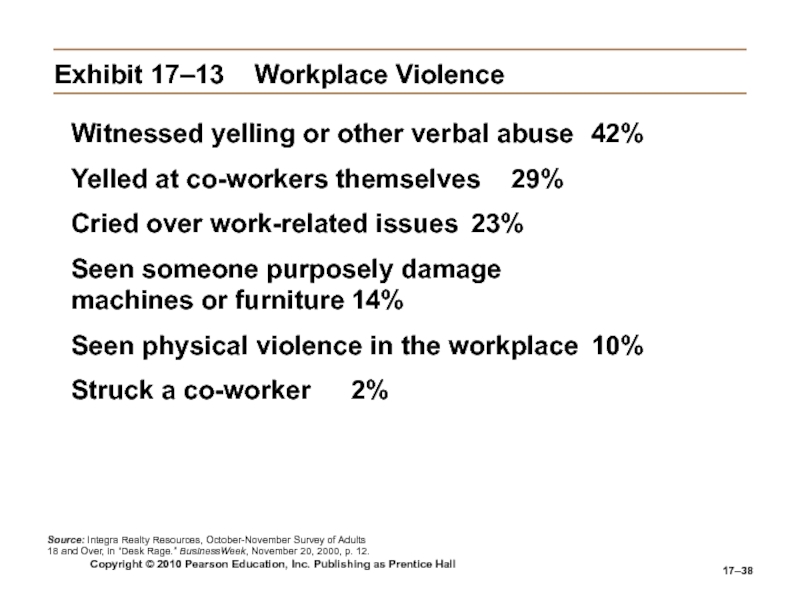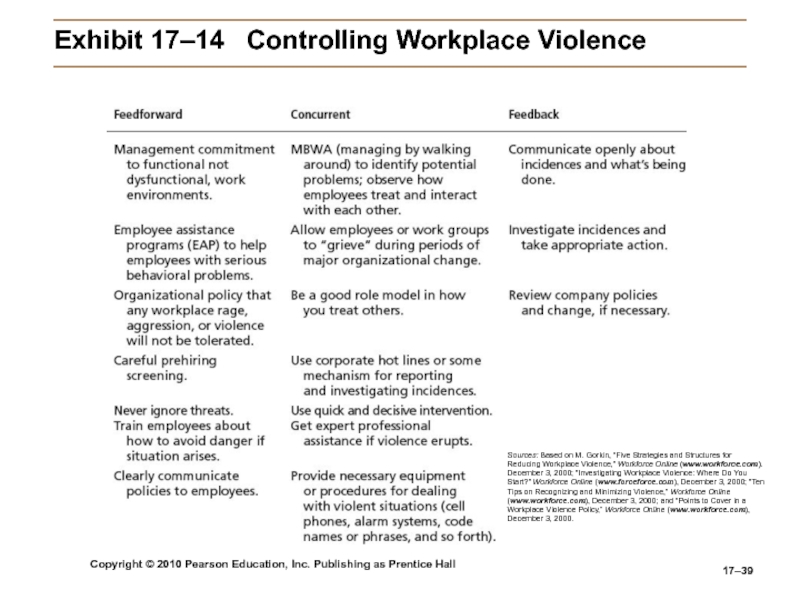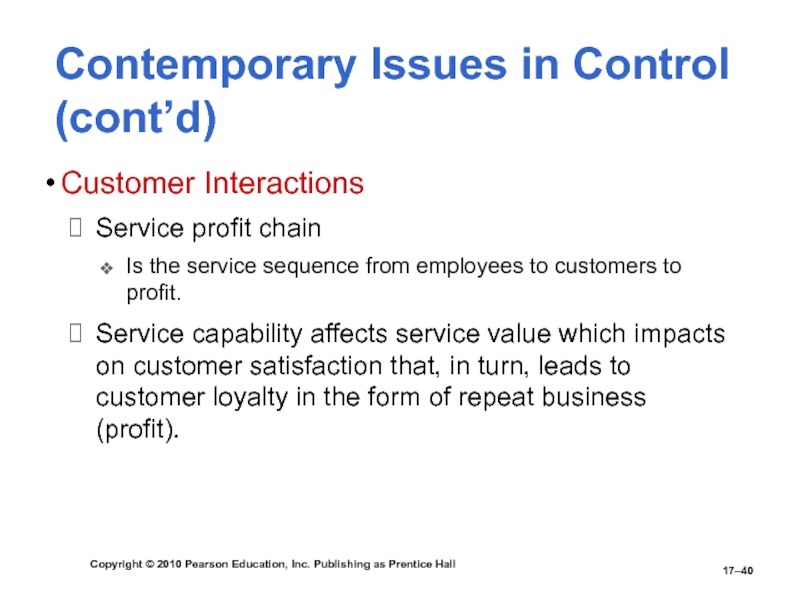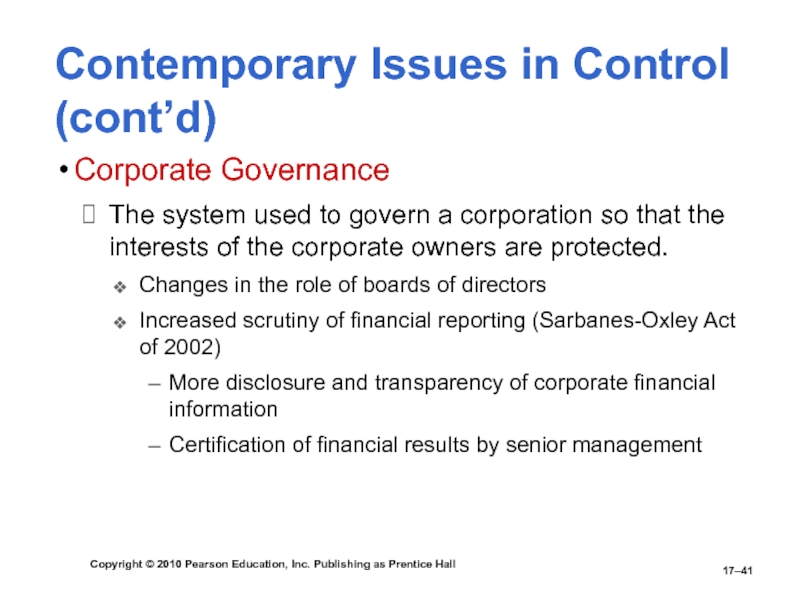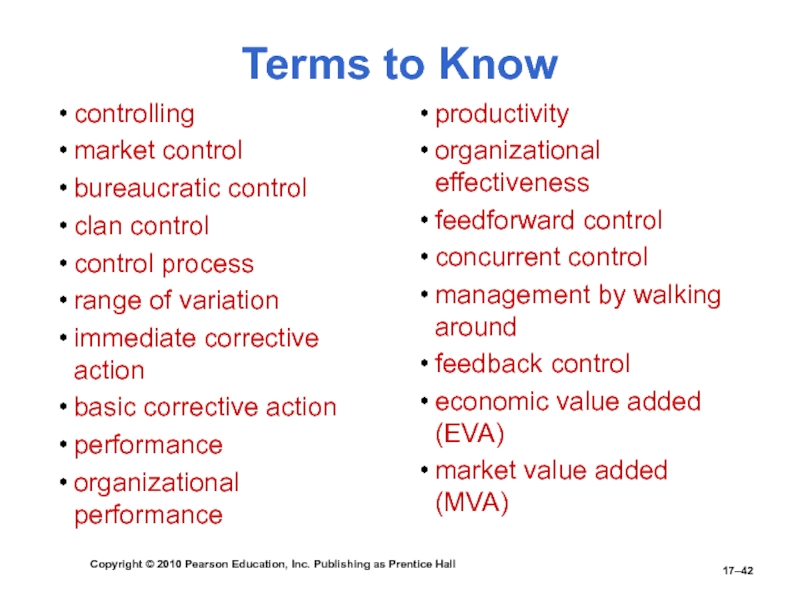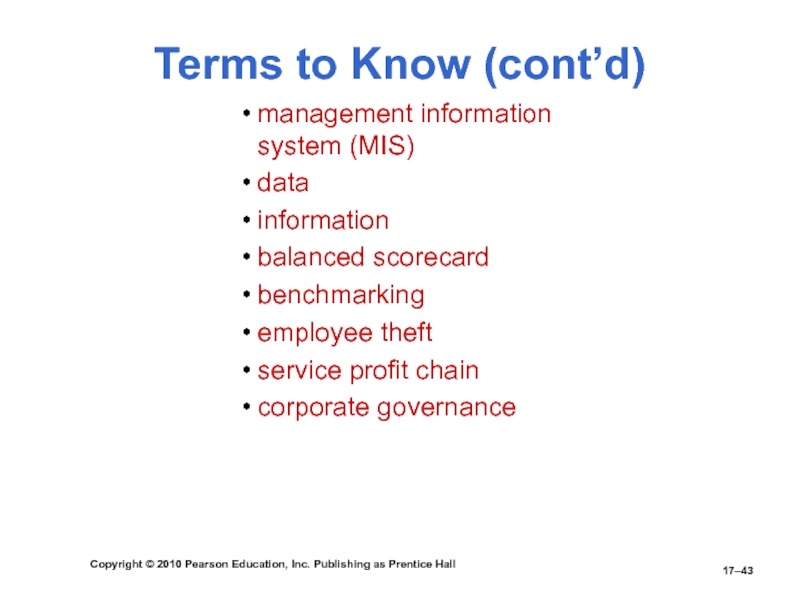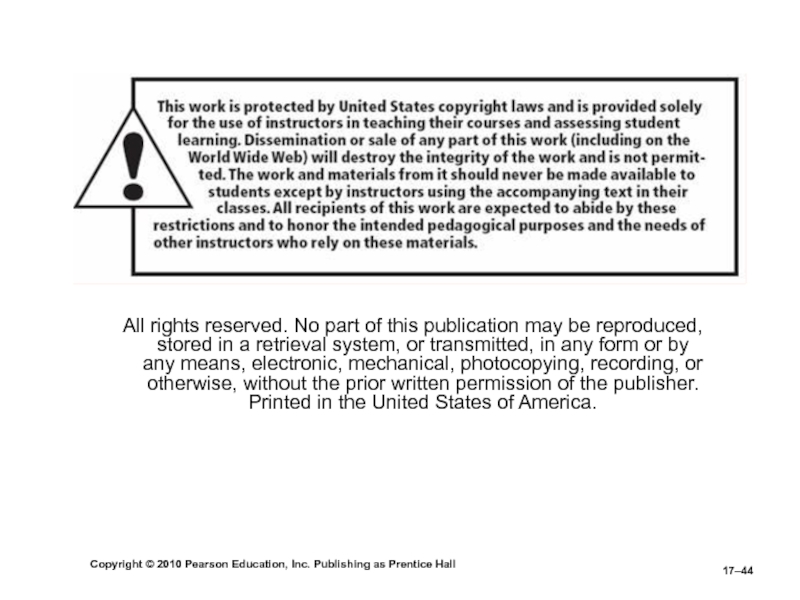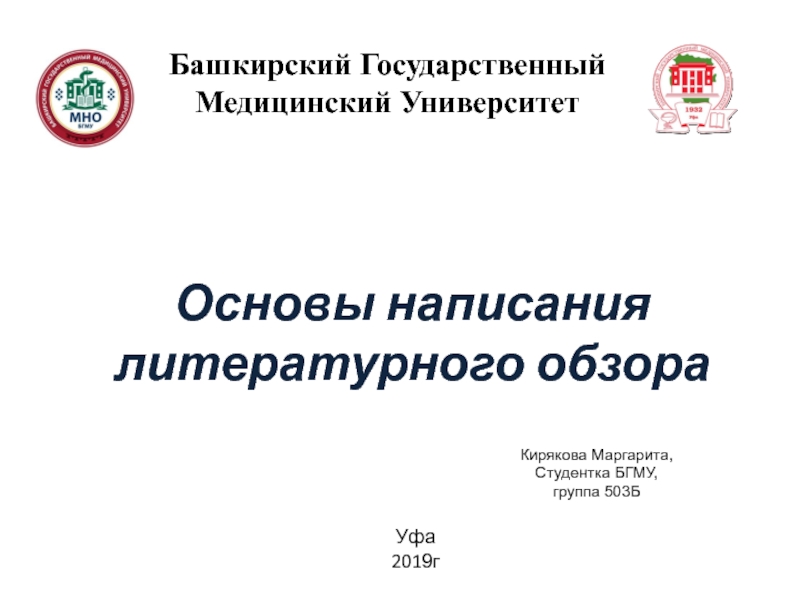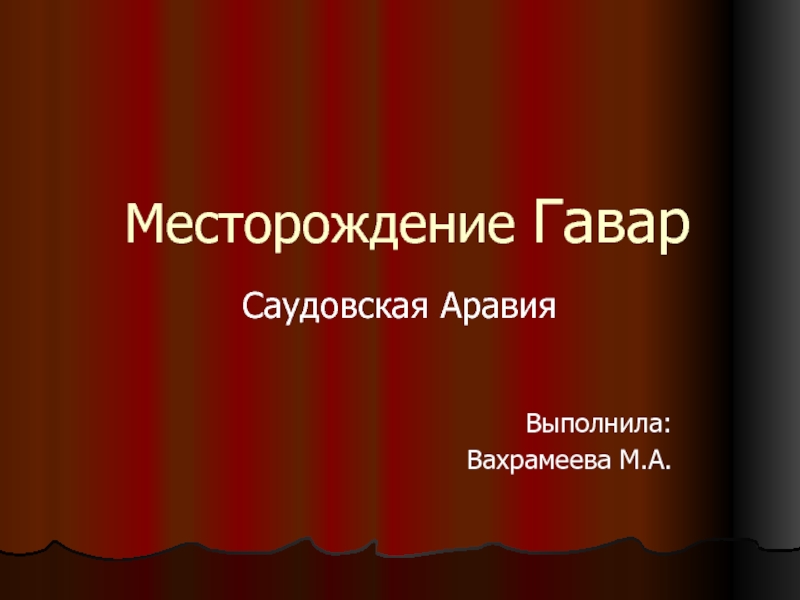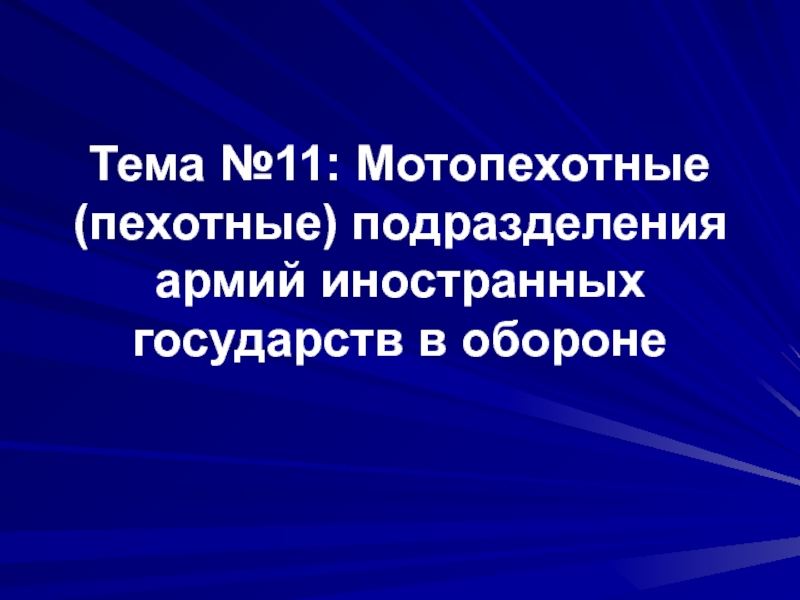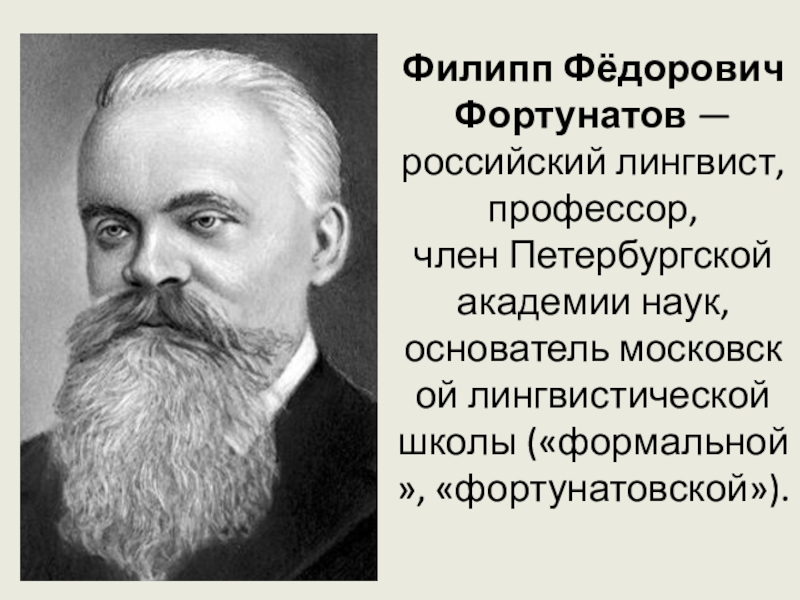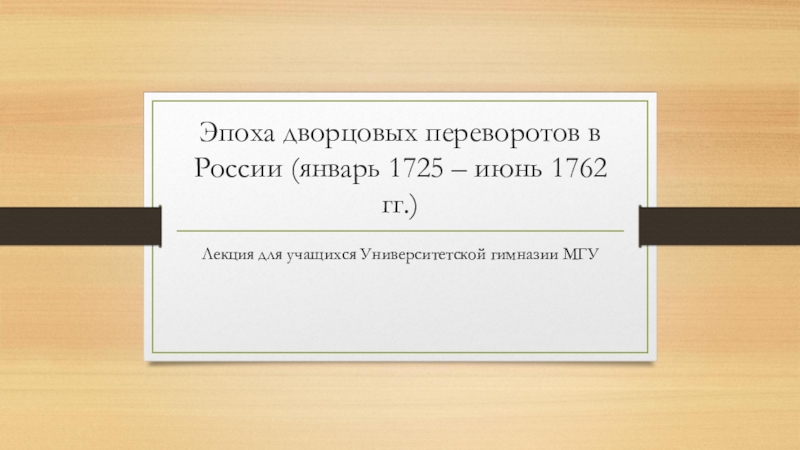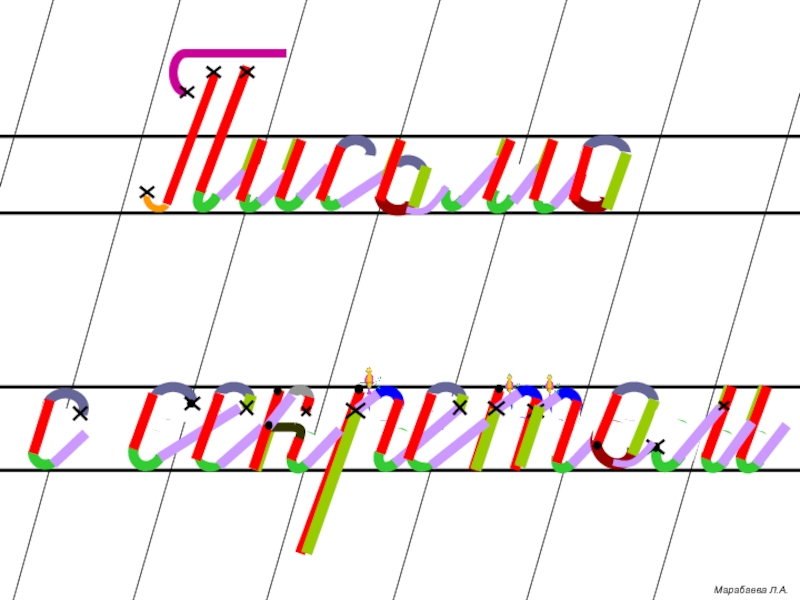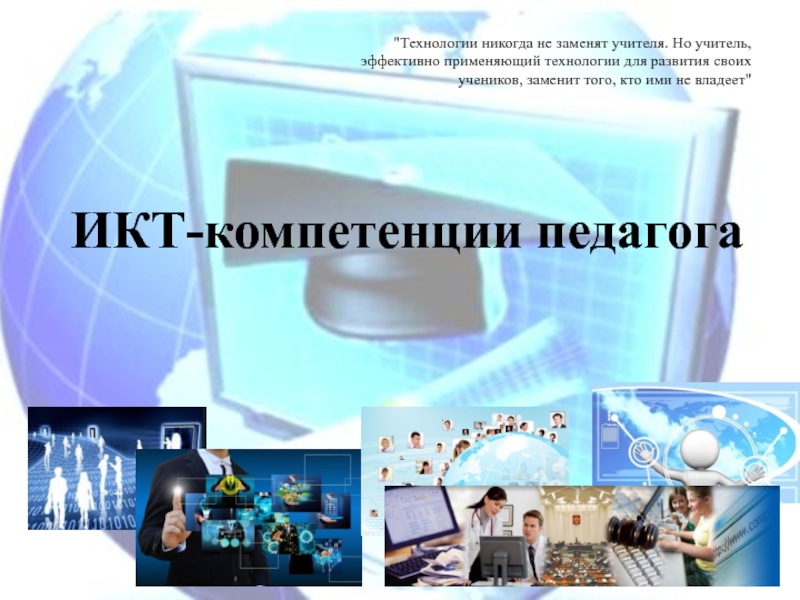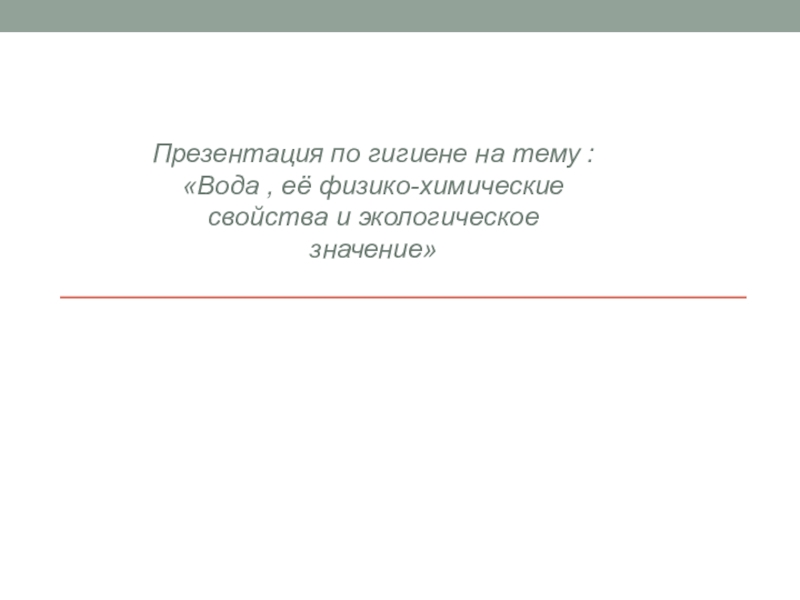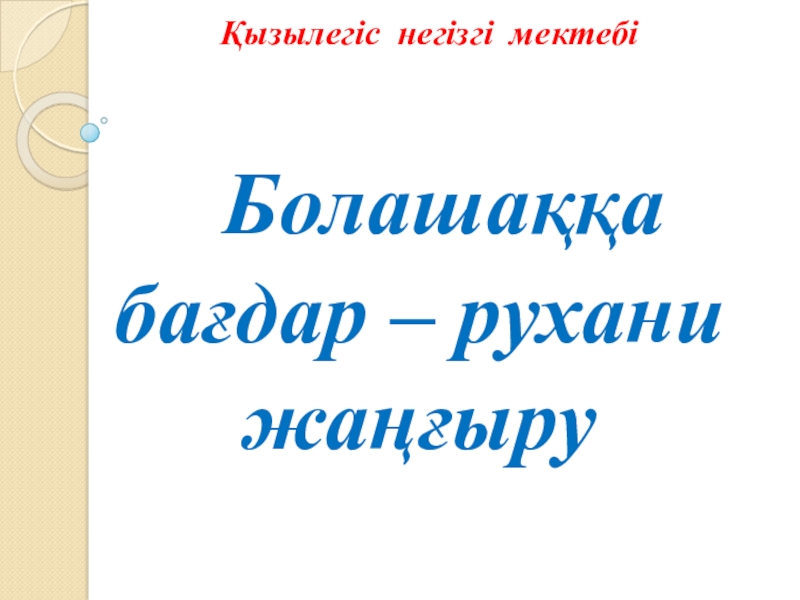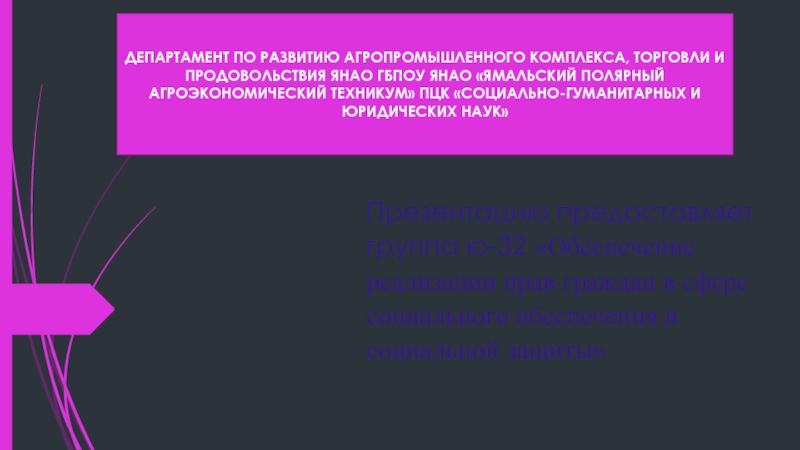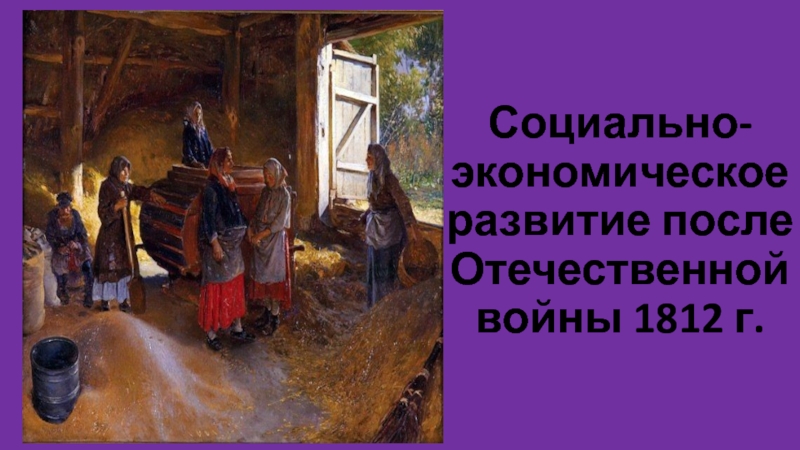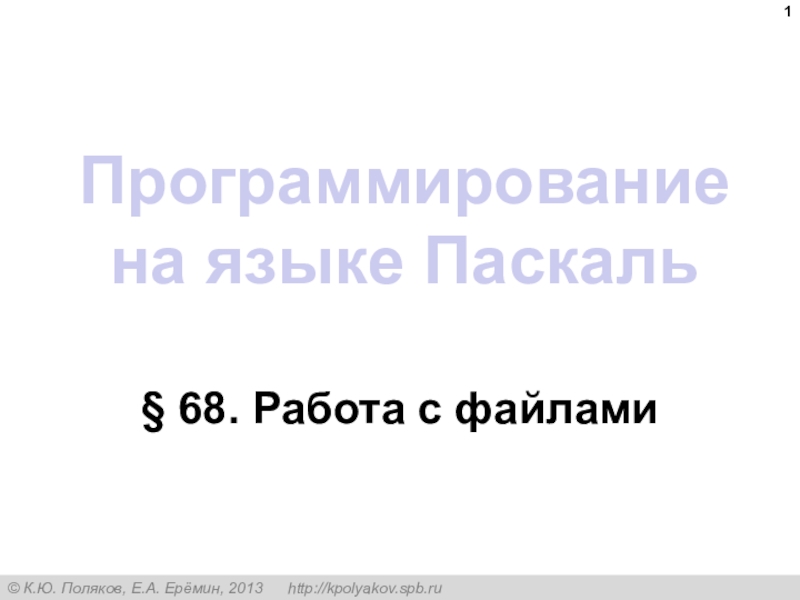Разделы презентаций
- Разное
- Английский язык
- Астрономия
- Алгебра
- Биология
- География
- Геометрия
- Детские презентации
- Информатика
- История
- Литература
- Математика
- Медицина
- Менеджмент
- Музыка
- МХК
- Немецкий язык
- ОБЖ
- Обществознание
- Окружающий мир
- Педагогика
- Русский язык
- Технология
- Физика
- Философия
- Химия
- Шаблоны, картинки для презентаций
- Экология
- Экономика
- Юриспруденция
Introduction to Controlling
Содержание
- 1. Introduction to Controlling
- 2. Copyright © 2010 Pearson Education, Inc. Publishing
- 3. Copyright © 2010 Pearson Education, Inc. Publishing
- 4. Copyright © 2010 Pearson Education, Inc. Publishing
- 5. Copyright © 2010 Pearson Education, Inc. Publishing
- 6. Copyright © 2010 Pearson Education, Inc. Publishing
- 7. Copyright © 2010 Pearson Education, Inc. Publishing as Prentice Hall17–Exhibit 17–1 The Planning–Controlling Link
- 8. Copyright © 2010 Pearson Education, Inc. Publishing
- 9. Copyright © 2010 Pearson Education, Inc. Publishing as Prentice Hall17–Exhibit 17–2 The Control Process
- 10. Copyright © 2010 Pearson Education, Inc. Publishing
- 11. Copyright © 2010 Pearson Education, Inc. Publishing
- 12. Copyright © 2010 Pearson Education, Inc. Publishing
- 13. Copyright © 2010 Pearson Education, Inc. Publishing
- 14. Copyright © 2010 Pearson Education, Inc. Publishing
- 15. Copyright © 2010 Pearson Education, Inc. Publishing
- 16. Copyright © 2010 Pearson Education, Inc. Publishing
- 17. Copyright © 2010 Pearson Education, Inc. Publishing
- 18. Copyright © 2010 Pearson Education, Inc. Publishing
- 19. Copyright © 2010 Pearson Education, Inc. Publishing
- 20. Copyright © 2010 Pearson Education, Inc. Publishing
- 21. Copyright © 2010 Pearson Education, Inc. Publishing
- 22. Copyright © 2010 Pearson Education, Inc. Publishing as Prentice Hall17–Exhibit 17–7 Popular Industry and Company Rankings
- 23. Copyright © 2010 Pearson Education, Inc. Publishing
- 24. Copyright © 2010 Pearson Education, Inc. Publishing
- 25. Copyright © 2010 Pearson Education, Inc. Publishing as Prentice Hall17–Exhibit 17–8 Types of Control
- 26. Copyright © 2010 Pearson Education, Inc. Publishing as Prentice Hall17–Financial ControlsTraditional ControlsRatio analysisLiquidityLeverageActivityProfitabilityBudget AnalysisQuantitative standardsDeviations
- 27. Copyright © 2010 Pearson Education, Inc. Publishing as Prentice Hall17–Exhibit 17–9 Popular Financial RatiosObjective Ratio Calculation Meaning
- 28. Copyright © 2010 Pearson Education, Inc. Publishing as Prentice Hall17–Exhibit 17–9 Popular Financial Ratios (cont’d)Objective Ratio Calculation Meaning
- 29. Copyright © 2010 Pearson Education, Inc. Publishing
- 30. Copyright © 2010 Pearson Education, Inc. Publishing
- 31. Copyright © 2010 Pearson Education, Inc. Publishing
- 32. Copyright © 2010 Pearson Education, Inc. Publishing
- 33. Copyright © 2010 Pearson Education, Inc. Publishing
- 34. Copyright © 2010 Pearson Education, Inc. Publishing
- 35. Copyright © 2010 Pearson Education, Inc. Publishing
- 36. Copyright © 2010 Pearson Education, Inc. Publishing
- 37. Copyright © 2010 Pearson Education, Inc. Publishing
- 38. Copyright © 2010 Pearson Education, Inc. Publishing
- 39. Copyright © 2010 Pearson Education, Inc. Publishing
- 40. Copyright © 2010 Pearson Education, Inc. Publishing
- 41. Copyright © 2010 Pearson Education, Inc. Publishing
- 42. Copyright © 2010 Pearson Education, Inc. Publishing
- 43. Copyright © 2010 Pearson Education, Inc. Publishing
- 44. Copyright © 2010 Pearson Education, Inc. Publishing
- 45. Скачать презентанцию
Слайды и текст этой презентации
Слайд 1Copyright © 2010 Pearson Education, Inc. Publishing as Prentice Hall
17–
Introduction
to
Controlling
Слайд 2Copyright © 2010 Pearson Education, Inc. Publishing as Prentice Hall
17–
Learning
Outcomes Follow this Learning Outline as you read and study this
chapter.17.1 What Is Control and Why Is It Important?
Define controlling.
Discuss the reasons why control is important.
Explain the planning-controlling link.
17.2 The Control Process
Describe the three steps in the control process.
Explain why what is measured is more critical than how it’s measured.
Explain the three courses of action managers can take in controlling.
Слайд 3Copyright © 2010 Pearson Education, Inc. Publishing as Prentice Hall
17–
Learning
Outcomes
17.3 Controlling Organizational Performance
Define organizational performance.
Describe three most frequently used
measures of organizational performance.17.4 Tools for Measuring Organizational Performance
Contrast feedforward, concurrent, and feedback controls.
Explain the types of financial and information controls managers can use.
Describe how balanced scorecards and benchmarking are used in controlling.
Слайд 4Copyright © 2010 Pearson Education, Inc. Publishing as Prentice Hall
17–
Learning
Outcomes
17.5 Contemporary Issues in Control
Describe how managers may have to
adjust controls for cross-cultural differences.Discuss the types of workplace concerns managers face and how they can address those concerns.
Explain why control is important to customer interactions.
Define corporate governance.
Слайд 5Copyright © 2010 Pearson Education, Inc. Publishing as Prentice Hall
17–
What
Is Control?
Controlling
The process of monitoring activities to ensure that they
are being accomplished as planned and of correcting any significant deviations.The Purpose of Control
To ensure that activities are completed in ways that lead to accomplishment of organizational goals.
Слайд 6Copyright © 2010 Pearson Education, Inc. Publishing as Prentice Hall
17–
Why
Is Control Important?
As the final link in management functions:
Planning
Controls let
managers know whether their goals and plans are on target and what future actions to take.Empowering employees
Control systems provide managers with information and feedback on employee performance.
Protecting the workplace
Controls enhance physical security and help minimize workplace disruptions.
Слайд 7Copyright © 2010 Pearson Education, Inc. Publishing as Prentice Hall
17–
Exhibit
17–1 The Planning–Controlling Link
Слайд 8Copyright © 2010 Pearson Education, Inc. Publishing as Prentice Hall
17–
The
Control Process
The Process of Control
Measuring actual performance.
Comparing actual performance against
a standard.Taking action to correct deviations or inadequate standards.
Слайд 9Copyright © 2010 Pearson Education, Inc. Publishing as Prentice Hall
17–
Exhibit
17–2 The Control Process
Слайд 10Copyright © 2010 Pearson Education, Inc. Publishing as Prentice Hall
17–
Measuring:
How and What We Measure
Sources of Information (How)
Personal observation
Statistical reports
Oral
reportsWritten reports
Control Criteria (What)
Employees
Satisfaction
Turnover
Absenteeism
Budgets
Costs
Output
Sales
Слайд 11Copyright © 2010 Pearson Education, Inc. Publishing as Prentice Hall
17–
Exhibit
17–3 Common Sources of Information for
Measuring Performance
Слайд 12Copyright © 2010 Pearson Education, Inc. Publishing as Prentice Hall
17–
Comparing
Determining
the degree of variation between actual performance and the standard.
Significance
of variation is determined by:The acceptable range of variation from the standard (forecast or budget).
The size (large or small) and direction (over or under) of the variation from the standard (forecast or budget).
Слайд 13Copyright © 2010 Pearson Education, Inc. Publishing as Prentice Hall
17–
Exhibit
17–4 Defining the Acceptable Range of
VariationСлайд 14Copyright © 2010 Pearson Education, Inc. Publishing as Prentice Hall
17–
Exhibit
17–5 Example of Determining Significant Variation
Слайд 15Copyright © 2010 Pearson Education, Inc. Publishing as Prentice Hall
17–
Taking
Managerial Action
Courses of Action
“Doing nothing”
Only if deviation is judged to
be insignificant.Correcting actual (current) performance
Immediate corrective action to correct the problem at once.
Basic corrective action to locate and to correct the source of the deviation.
Corrective Actions
Change strategy, structure, compensation scheme, or training programs; redesign jobs; or fire employees
Слайд 16Copyright © 2010 Pearson Education, Inc. Publishing as Prentice Hall
17–
Taking
Managerial Action
Courses of Action (cont’d)
Revising the standard
Examining the standard to
ascertain whether or not the standard is realistic, fair, and achievable.Upholding the validity of the standard.
Resetting goals that were initially set too low or too high.
Слайд 17Copyright © 2010 Pearson Education, Inc. Publishing as Prentice Hall
17–
Exhibit
17–6 Managerial Decisions in the Control
Process
Слайд 18Copyright © 2010 Pearson Education, Inc. Publishing as Prentice Hall
17–
Controlling
for Organizational Performance
What Is Performance?
The end result of an activity
What
Is Organizational
Performance?The accumulated end results of all of the organization’s work processes and activities
Designing strategies, work processes, and work activities.
Coordinating the work of employees.
Слайд 19Copyright © 2010 Pearson Education, Inc. Publishing as Prentice Hall
17–
Organizational
Performance Measures
Organizational Productivity
Productivity: the overall output of goods and/or
services divided by the inputs needed to generate that output.Output: sales revenues
Inputs: costs of resources (materials, labor expense, and facilities)
Ultimately, productivity is a measure of how efficiently employees do their work.
Слайд 20Copyright © 2010 Pearson Education, Inc. Publishing as Prentice Hall
17–
Organizational
Performance Measures (cont’d)
Organizational Effectiveness
Measuring how appropriate organizational goals are and
how well the organization is achieving its goals.Systems resource model
The ability of the organization to exploit its environment in acquiring scarce and valued resources.
The process model
The efficiency of an organization’s transformation process in converting inputs to outputs.
The multiple constituencies model
The effectiveness of the organization in meeting each constituencies’ needs.
Слайд 21Copyright © 2010 Pearson Education, Inc. Publishing as Prentice Hall
17–
Industry
and Company Rankings
Industry rankings on:
Profits
Return on revenue
Return on shareholders’ equity
Growth
in profitsRevenues per employee
Revenues per dollar of assets
Revenues per dollar of equity
Corporate Culture Audits
Compensation and benefits surveys
Customer satisfaction
surveys
Слайд 22Copyright © 2010 Pearson Education, Inc. Publishing as Prentice Hall
17–
Exhibit
17–7 Popular Industry and Company Rankings
Слайд 23Copyright © 2010 Pearson Education, Inc. Publishing as Prentice Hall
17–
Tools
for Measuring Organizational Performance
Feedforward Control
A control that prevents anticipated problems
before actual occurrences of the problem.Building in quality through design.
Requiring suppliers conform to ISO 9002.
Concurrent Control
A control that takes place while the monitored activity is in progress.
Direct supervision: management by walking around.
Слайд 24Copyright © 2010 Pearson Education, Inc. Publishing as Prentice Hall
17–
Tools
for Measuring Organizational Performance (cont’d)
Feedback Control
A control that takes place
after an activity is done.Corrective action is after-the-fact, when the problem has already occurred.
Advantages of feedback controls:
Provide managers with information on the effectiveness of their planning efforts.
Enhance employee motivation by providing them with information on how well they are doing.
Слайд 25Copyright © 2010 Pearson Education, Inc. Publishing as Prentice Hall
17–
Exhibit
17–8 Types of Control
Слайд 26Copyright © 2010 Pearson Education, Inc. Publishing as Prentice Hall
17–
Financial
Controls
Traditional Controls
Ratio analysis
Liquidity
Leverage
Activity
Profitability
Budget Analysis
Quantitative standards
Deviations
Слайд 27Copyright © 2010 Pearson Education, Inc. Publishing as Prentice Hall
17–
Exhibit
17–9 Popular Financial Ratios
Objective Ratio Calculation Meaning
Слайд 28Copyright © 2010 Pearson Education, Inc. Publishing as Prentice Hall
17–
Exhibit
17–9 Popular Financial Ratios (cont’d)
Objective Ratio Calculation Meaning
Слайд 29Copyright © 2010 Pearson Education, Inc. Publishing as Prentice Hall
17–
Financial
Controls
Managing Earnings
“Timing” income and expenses to enhance current financial results,
which gives an unrealistic picture of the organization’s financial performance.New laws and regulations require companies to clarify their financial information.
Слайд 30Copyright © 2010 Pearson Education, Inc. Publishing as Prentice Hall
17–
Tools
for Measuring Organizational Performance (cont’d.)
Balanced Scorecard
Is a measurement tool that
uses goals set by managers in four areas to measure a company’s performance:Financial
Customer
Internal processes
People/innovation/growth assets
Is intended to emphasize that all of these areas are important to an organization’s success and that there should be a balance among them.
Слайд 31Copyright © 2010 Pearson Education, Inc. Publishing as Prentice Hall
17–
Information
Controls
Purposes of Information Controls
As a tool to help managers control
other organizational activities.Managers need the right information at the right time and in the right amount.
As an organizational area that managers need to control.
Managers must have comprehensive and secure controls in place to protect the organization’s important information.
Слайд 32Copyright © 2010 Pearson Education, Inc. Publishing as Prentice Hall
17–
Information
Controls (cont’d)
Management Information Systems (MIS)
A system used to provide management
with needed information on a regular basis.Data: an unorganized collection of raw, unanalyzed facts (e.g., unsorted list of customer names).
Information: data that has been analyzed and organized such that it has value and relevance to managers.
Слайд 33Copyright © 2010 Pearson Education, Inc. Publishing as Prentice Hall
17–
Benchmarking
of Best Practices
Benchmark
The standard of excellence against which to measure
and compare.Benchmarking
Is the search for the best practices among competitors or noncompetitors that lead to their superior performance.
Is a control tool for identifying and measuring specific performance gaps and areas for improvement.
Слайд 34Copyright © 2010 Pearson Education, Inc. Publishing as Prentice Hall
17–
Contemporary
Issues in Control
Cross-Cultural Issues
The use of technology to increase direct
corporate control of local operationsLegal constraints on corrective actions in foreign countries
Difficulty with the comparability of data collected from operations in different countries
Слайд 35Copyright © 2010 Pearson Education, Inc. Publishing as Prentice Hall
17–
Contemporary
Issues in Control (cont’d)
Workplace Concerns
Workplace privacy versus workplace monitoring:
E-mail, telephone,
computer, and Internet usageProductivity, harassment, security, confidentiality, intellectual property protection
Employee theft
The unauthorized taking of company property by employees for their personal use.
Workplace violence
Anger, rage, and violence in the workplace is affecting employee productivity.
Слайд 36Copyright © 2010 Pearson Education, Inc. Publishing as Prentice Hall
17–
Exhibit
17–11 Top Internet Video Sites Viewed
at Work Top 10 Internet video brands viewed in the U.S. while at work for January 2008, in millions of streamsSource: Bobby White, “The New
Workplace Rules: No Video
Watching,” Wall Street Journal,
March 4, 2008, p. B3.
Слайд 37Copyright © 2010 Pearson Education, Inc. Publishing as Prentice Hall
17–
Exhibit
17–12 Controlling Employee Theft
Sources: Based on A.H. Bell and
D.M. Smith. “Protecting the Company Against Theft and Fraud,” Workforce Online (www.workforce.com) December 3, 2000; J.D. Hansen. “To Catch a Thief,” Journal of Accountancy, March 2000, pp. 43–46; and J. Greenberg, “The Cognitive Geometry of Employee Theft,” in Dysfunctional Behavior in Organizations: Nonviolent and Deviant Behavior, eds. S.B. Bacharach, A. O’Leary-Kelly, J.M. Collins, and R.W. Griffin (Stamford, CT: JAI Press, 1998), pp. 147–93.Слайд 38Copyright © 2010 Pearson Education, Inc. Publishing as Prentice Hall
17–
Exhibit
17–13 Workplace Violence
Witnessed yelling or other verbal abuse 42%
Yelled at co-workers themselves 29%
Cried
over work-related issues 23%Seen someone purposely damage machines or furniture 14%
Seen physical violence in the workplace 10%
Struck a co-worker 2%
Source: Integra Realty Resources, October-November Survey of Adults 18 and Over, in “Desk Rage.” BusinessWeek, November 20, 2000, p. 12.
Слайд 39Copyright © 2010 Pearson Education, Inc. Publishing as Prentice Hall
17–
Exhibit
17–14 Controlling Workplace Violence
Sources: Based on M. Gorkin, “Five
Strategies and Structures for Reducing Workplace Violence,” Workforce Online (www.workforce.com). December 3, 2000; “Investigating Workplace Violence: Where Do You Start?” Workforce Online (www.forceforce.com), December 3, 2000; “Ten Tips on Recognizing and Minimizing Violence,” Workforce Online (www.workforce.com), December 3, 2000; and “Points to Cover in a Workplace Violence Policy,” Workforce Online (www.workforce.com), December 3, 2000.Слайд 40Copyright © 2010 Pearson Education, Inc. Publishing as Prentice Hall
17–
Contemporary
Issues in Control (cont’d)
Customer Interactions
Service profit chain
Is the service sequence
from employees to customers to profit. Service capability affects service value which impacts on customer satisfaction that, in turn, leads to customer loyalty in the form of repeat business (profit).
Слайд 41Copyright © 2010 Pearson Education, Inc. Publishing as Prentice Hall
17–
Contemporary
Issues in Control (cont’d)
Corporate Governance
The system used to govern a
corporation so that the interests of the corporate owners are protected.Changes in the role of boards of directors
Increased scrutiny of financial reporting (Sarbanes-Oxley Act of 2002)
More disclosure and transparency of corporate financial information
Certification of financial results by senior management
Слайд 42Copyright © 2010 Pearson Education, Inc. Publishing as Prentice Hall
17–
Terms
to Know
controlling
market control
bureaucratic control
clan control
control process
range of variation
immediate corrective action
basic
corrective actionperformance
organizational performance
productivity
organizational effectiveness
feedforward control
concurrent control
management by walking around
feedback control
economic value added (EVA)
market value added (MVA)
